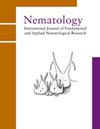描述中国三棱苣苔和直立苣苔根瘤中的三棱苣苔(Dorylaimida: Longidoridae)
IF 1.2
4区 生物学
Q2 ZOOLOGY
引用次数: 0
摘要
Longidorus sanlitanensis n. sp.从中国内蒙古自治区的Melilotoides ruthenica和Chamaerhodos erecta的根瘤中发现,利用形态学和分子数据对其进行了描述和说明。新种的特征是:雌虫体长中等(4.0-4.8 毫米),唇区前部圆形,与身体其他部分之间有凹陷,两鳃袋呈口袋状,导环位于 58.4-66.咽球长 68.7-79.7 μm,短圆锥形尾,末端宽圆,有四个幼体发育阶段(未发现 J1),无雄体。根据导环距身体前端的距离、身体和尾柄的长度以及唇区形状的相似性,将该新物种与 9 个相似物种进行了比较,它们是L. litchi、L. diadecturus、L. fursti、L. himalayensis、L. jonesi、L. wiesae、L. macromucronatus、L. fangi 和 L. zhengi。新物种的矩阵代码为A4-B2-C5-D4-E1-F2-G2-H12-I2-J1-K?.利用 rRNA 基因的近全长 18S、ITS1 和 28S D2-D3 区域重建了新物种与其他相关物种的系统发生关系,并讨论了所得出的拓扑结构。在 18S 系统发育中,L. sanlitanensis n. sp.与 L. litchi 组成一个大支系,其中包括具有后位指导环的物种;在 28S 系统发育中,它与具有后位指导环的物种关系密切。这是中国记录的第22个龙齿属物种。本文章由计算机程序翻译,如有差异,请以英文原文为准。
Description of Longidorus sanlitanensis n. sp. (Dorylaimida: Longidoridae) from the rhizosphere of Melilotoides ruthenica and Chamaerhodos erecta in China
Longidorus sanlitanensis n. sp. was recovered from the rhizosphere of Melilotoides ruthenica and Chamaerhodos erecta in the Inner Mongolia Autonomous Region, P.R. China, and was described and illustrated using morphological and molecular data. The new species is characterised by medium body length of females (4.0-4.8 mm), lip region anteriorly rounded and separated from the rest of the body by a depression, pocket-shaped amphidial pouches, the guiding ring located at 58.4-66.0 μm from the anterior end, odontostyle and odontophore 107.2-114.6 and 71.6-77.8 μm long, respectively, the pharyngeal bulb 68.7-79.7 μm long, a short conical tail with a broadly rounded terminus, four juvenile developmental stages (J1 was not detected) and males absent. By similarities in the distance of the guiding ring from the anterior body end, body and odontostyle length and lip region shape, the new species was compared with nine similar species, namely: L. litchi, L. diadecturus, L. fursti, L. himalayensis, L. jonesi, L. wiesae, L. macromucronatus, L. fangi and L. zhengi. The matrix code of the new species is: A4-B2-C5-D4-E1-F2-G2-H12-I2-J1-K?. The phylogenetic relationships of the new species with other relevant species were reconstructed using near-full-length 18S, ITS1 and 28S D2-D3 regions of rRNA gene and the resulted topologies were discussed. In 18S phylogeny, L. sanlitanensis n. sp. formed a clade with L. litchi inside a major clade, including species with a posteriorly located guiding ring, and in 28S phylogeny it showed close relationships with species having a posteriorly located guiding ring. This is the 22nd Longidorus species recorded from China.
求助全文
通过发布文献求助,成功后即可免费获取论文全文。
去求助
来源期刊

Nematology
生物-动物学
CiteScore
2.60
自引率
33.30%
发文量
67
审稿时长
3 months
期刊介绍:
Nematology is an international journal for the publication of all aspects of nematological research (with the exception of vertebrate parasitology), from molecular biology to field studies. Papers on nematode parasites of arthropods, and on soil free-living nematodes, and on interactions of these and other organisms, are particularly welcome. Research on fresh water and marine nematodes is also considered when the observations are of more general interest.
Nematology publishes full research papers, short communications, Forum articles (which permit an author to express a view on current or fundamental subjects), perspectives on nematology, and reviews of books and other media.
 求助内容:
求助内容: 应助结果提醒方式:
应助结果提醒方式:


